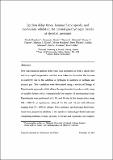| dc.contributor.author | Donohoe, Nicola | |
| dc.contributor.author | Heufer, Alexander | |
| dc.contributor.author | Metcalfe, Wayne K. | |
| dc.contributor.author | Curran, Henry J. | |
| dc.contributor.author | Davis, Marissa L. | |
| dc.contributor.author | Mathieu, Olivier | |
| dc.contributor.author | Plichta, Drew | |
| dc.contributor.author | Morones, Anibal | |
| dc.contributor.author | Petersen, Eric L. | |
| dc.contributor.author | Güthe, Felix | |
| dc.date.accessioned | 2016-11-01T15:43:06Z | |
| dc.date.available | 2016-11-01T15:43:06Z | |
| dc.date.issued | 2013-12-30 | |
| dc.identifier.citation | Donohoe, N,Heufer, A,Metcalfe, WK,Curran, HJ,Davis, ML,Mathieu, O,Plichta, D,Morones, A,Petersen, EL,Guthe, F (2014) 'Ignition delay times, laminar flame speeds, and mechanism validation for natural gas/hydrogen blends at elevated pressures' Combustion and Flame, 161(6), 1432-1443. doi: http://dx.doi.org/10.1016/j.combustflame.2013.12.005 | en_IE |
| dc.identifier.issn | 1556-2921 | |
| dc.identifier.uri | http://hdl.handle.net/10379/6111 | |
| dc.description.abstract | New experimental ignition delay time data measured in both a shock tube and in a rapid compression machine were taken to determine the increase in reactivity due to the addition of hydrogen to mixtures of methane and natural gas. Test conditions were determined using a statistical design of experiments approach which allows the experimenter to probe a wide range of variable factors with a comparatively low number of experimental trials. Experiments were performed at 1, 10, and 30 atm in the temperature range 850-1800 K, at equivalence ratios of 0.3, 0.5, and 1.0 and with dilutions ranging from 72% to 90% by volume. Pure methane- and hydrogen-fueled mixtures were prepared in addition to two synthetic 'natural gas'-fueled mixtures comprising methane, ethane, propane, n-butane and n-pentane, one comprising 81.25/10/5/2.511.25% while the other consisted of 62.5/20/10/5/2.5% C-1/C-2/C-3/C-4/Cs components to encompass a wide range of possible natural gas compositions. A heated, constant-volume combustion vessel was also utilized to experimentally determine laminar flame speed for the same baseline range of fuels. In this test, a parametric sweep of equivalence ratio, 0.7-1.3, was conducted at each condition, and the hydrogen content was varied from 50% to 90% by volume. The initial temperature and pressure varied from 300 to 450 K and 1 to 5 atm, respectively. Flame speed experiments conducted above atmospheric pressure utilized a 1:6 oxygen-to-helium ratio to curb the hydrodynamic and thermal instabilities that arise when conducting laminar flame speed experiments. All experiments were simulated using a detailed chemical kinetic model. Overall good agreement is observed between the simulations and the experimental results. A discussion of the important reactions promoting and inhibiting reactivity is included. (C) 2013 The Combustion Institute. Published by Elsevier Inc. All rights reserved. | en_IE |
| dc.description.sponsorship | This work was supported by Science Foundation Ireland under Grant No. [08/IN1./I2055]. We also acknowledge the support of
Alstom Power Ltd. A. Morones was supported by CONANCYT of Mexico and CIDESI, and M. Davis was supported in part by a Graduate Diversity Fellowship from Texas A&M University. | en_IE |
| dc.format | application/pdf | en_IE |
| dc.language.iso | en | en_IE |
| dc.publisher | Elsevier | en_IE |
| dc.relation.ispartof | Combustion And Flame | en |
| dc.rights | Attribution-NonCommercial-NoDerivs 3.0 Ireland | |
| dc.rights.uri | https://creativecommons.org/licenses/by-nc-nd/3.0/ie/ | |
| dc.subject | Hydrogen | en_IE |
| dc.subject | Natural gas | en_IE |
| dc.subject | Rapid compression machine | en_IE |
| dc.subject | Shock tube | en_IE |
| dc.subject | Flame speed | en_IE |
| dc.subject | Chemistry | en_IE |
| dc.subject | Rapid compression machine | en_IE |
| dc.subject | Methane air mixtures | en_IE |
| dc.subject | Burning velocities | en_IE |
| dc.subject | Hydrogen air | en_IE |
| dc.subject | Shock waves | en_IE |
| dc.subject | Fuel blends | en_IE |
| dc.subject | Oxidation | en_IE |
| dc.subject | Hydrocarbon | en_IE |
| dc.subject | Autignition | en_IE |
| dc.subject | Temperature | en_IE |
| dc.title | Ignition delay times, laminar flame speeds, and mechanism validation for natural gas/hydrogen blends at elevated pressures | en_IE |
| dc.type | Article | en_IE |
| dc.date.updated | 2016-10-20T09:52:37Z | |
| dc.identifier.doi | 10.1016/j.combustflame.2013.12.005 | |
| dc.local.publishedsource | http://dx.doi.org/10.1016/j.combustflame.2013.12.005 | en_IE |
| dc.description.peer-reviewed | peer-reviewed | |
| dc.contributor.funder | |~| | |
| dc.internal.rssid | 6513555 | |
| dc.local.contact | Henry Curran, Dept Of Chemistry, Room 215, Arts/Science Building, Nui Galway. 3856 Email: henry.curran@nuigalway.ie | |
| dc.local.copyrightchecked | No | |
| dc.local.version | ACCEPTED | |
| nui.item.downloads | 1044 | |


